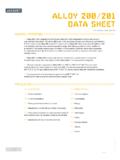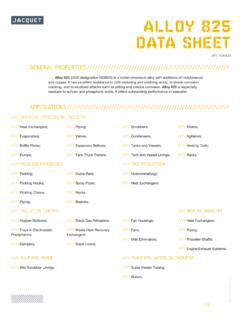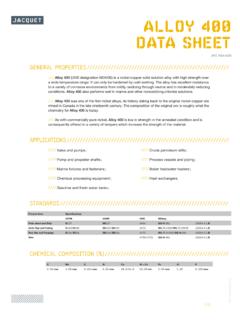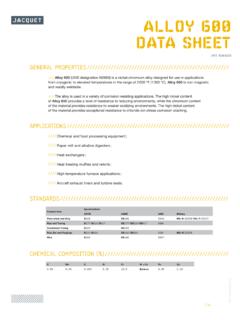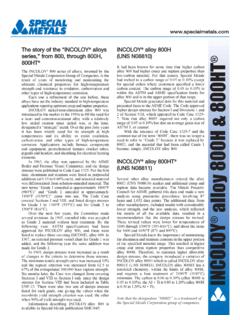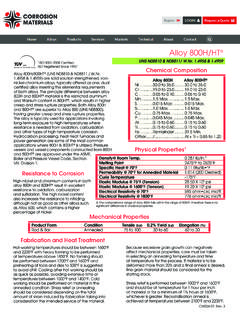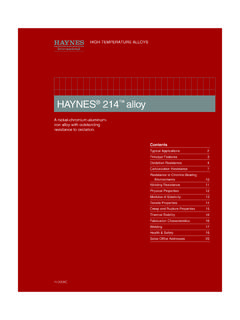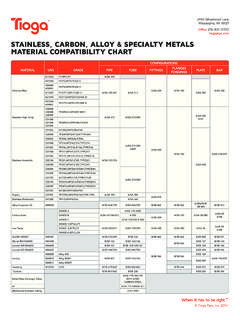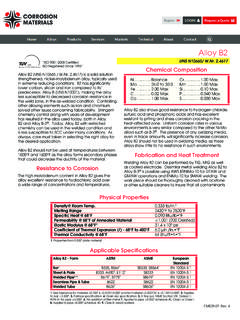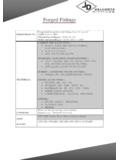Transcription of ALLOY 800 800H 800AT DATA SHEET - Jacquet …
1 1 / 6 For internal use 800 / 800h / 800 ATDATA SHEETUNS N08800 / UNS N08801 / UNS N08811//// ALLOY 800 (UNS N08800), ALLOY 800h (UNS N08810) and ALLOY 800AT (UNS N08811) are nickel-iron-chromium alloys designed to resist oxidation and carburization at elevated temperatures through 1 900 F. The nickel content, 32 %, makes the alloys highly resistant both to chloride stress corrosion cracking and to embrittlement from precipitation of sigma phase. The general corrosion resistance is excellent. In the solution annealed condition, alloys 800h and 80 0AT have superior creep and stress rupture properties.
2 All three versions of the basic ALLOY 800 have been approved as materials of construction under ASME Boiler and Pressure Valve Code, Section I-Power Boilers, Section III-Nuclear Vessels, and Section VIII-Unfired Pressure 800, ALLOY 800h and ALLOY 800AT are identical except for the higher level of carbon ( to %) in ALLOY 800h , and the addition of up to 1 % aluminum + titanium in ALLOY 800AT . The ALLOY 800 is normally used in this service at temperatures to approximately 1 100 F (593 C). ALLOY 800h and ALLOY 800AT are normally used above approximately 1 100 F (593 C)
3 Where resistance to creep and rupture is Industrial Heating Industry radiant tubes, return bends, muffles, retorts and furnace fixtures//// Petrochemical furnace cracker tubes//// Hydrocarbon Processing Industry catalyst tubing, convection tubing, outlet manifolds and quenching system piping//// Power Generation Industry steam superheating tubing, high temperature heat exchangers//// ALLOY 800, ALLOY 800h and ALLOY 800AT alloys are assigned maximum allowable stresses in the ASME Boiler and Pressure Vessel Code, Section VIII, Division 1, Table UNF up to 1 500 F (816 C).
4 These alloys are assigned maximum allowable stresses to higher temperatures than almost all other alloys covered in the ASME Code. Comparing the three alloys , ALLOY 800h and ALLOY 800AT are assigned higher maximum allowable stresses above 1 200 F (649 C), and ALLOY 800 is assigned higher maximum allowable stresses below 1 100 F (593 C). This corresponds to the temperature range where short time tensile properties become less important design criteria than resistance to creep and stress ruptureGENERAL PROPERTIES //////////////////////////////////////// //////////////APPLICATIONS //////////////////////////////////////// //////////////////////STANDARDS //////////////////////////////////////// ////////////////////////Product formSpecificationsASTMASMEAMSEN / WerkstoffPlate SHEET and / Pipe and tubingB163 / B407SB166 / / Pipe and /
5 And / / / 6 For internal use Strength % OffsetUltimate Tensile StrengthElongation F CpsiMPapsiMPa% in 2"702143 00029587 700600442009339 70027481 7005634350026034 00023476 2005253980042733 30023074 600514401 00053831 70021972 000496391 20064929 00020054 000372561 40076022 60015632 100221851 50081614 2009824 80017191 TemperatureYield Strength % OffsetUltimate Tensile StrengthElongation F CpsiMPapsiMPa% in 2"702129 00020077 000531522009324 10016671 0004905360031619 00013166 6004595380042718 10012565 800454531 00053816 50011463 500438511 20064914 80010255 700384501 40076014 4009932 300223781 60087111 6008018 6001281201 8009828 9006110 20070120mEC hANICAL PROPERTIES //////////////////////////////////////// ///////Ch EmICAL CO mPOSITION (%) //////////////////////////////////////// ///////AlloyCMnPSSiCrNiTiAlAl + TiCuFeASTM Grain or or coarsef//// TyPICAL PROPERTIES OF ALLOY 800 whICh wAS ANNEALED AT 1 800 F (928 C)
6 //// TyPICAL PROPERTIES OF ALLOY 800h AND 800AT whICh wAS ANNEALED AT 2 100 F (928 C)//// ShORT TImE ELEvATED TEmPERATURE PROPERTIES//// The two tables above illustrate the short time high-temperature tensile properties f alloys 800, 800h and 800AT . The strength of alloys 800h and 800AT is lower because the heat treatment of alloys 800h and 800AT at 2 100 F (1 149 C) results in a larger grain size to provide better creep and rupture stress rupture resistance. The 1 800 F (982 C) anneal of ALLOY 800 results in a finer grain size to provide better cold / 6 For internal use SICAL PROPERTIES //////////////////////////////////////// /////////////ELECTRICAL AND ThER mAL PROPERTIES ////////////////////////////////////mODU LUS OF ELASTICITy //////////////////////////////////////// ///////////DensityMagnetic PermeabilitySpecific HeatMelting lb / in375 F (21 C) and 200 Btu / lb- F F = g / ( kA / m)
7 460 J / kg- K C = 1357-1385 Annealed = Rolled = ResistivityThermal ConductivityCoefficient of Expansiona F C circ mil / ft / ft .h FW / m C10-6 in / in / Fmm / m / 0001 093788-----a : Magnetic PermeabilityTemperatureTensile ModulusShear Modulus Poisson's Ratio ( )b F C103 ksiGPa103 : Calculated from moduli of elasticity4 / 6 For internal use ALLOY 800 is highly resistant, although not totally immune, to stress corrosion cracking. In extensive field experience, ALLOY 800 has shown excellent service performance in many types of equipment in the petroleum, chemical, food, and pulp and paper industries.
8 Thus, although ALLOY 800 may offer a distinct advantage for use in moderately corrosive environments where service experience has indicated a tendency toward stress corrosion cracking of other austenitic stainless steels. However, the ALLOY is not immune to stress corrosion cracking as judged by the extremely severe magnesium chloride OxIDATION RESISTANCE//// alloys 800, 800h and 80 0AT are particularly well suited for high temperature applications such as furnace parts and related heating equipment, for petrochemical reforming units and isocracker tubes, and for handling superheated steam in nuclear and conventional power plants.
9 With the specified high levels of chromium and nickel, the alloys offer superior resistance to oxidation and scaling, and to carburization as The following oxidation data for ALLOY 800 were obtained by exposing samples to the indicated temperature for 100 hours in still air and cooling. In general, total weight gains greater than 10 mg / cm indicate that additional exposure at these temperatures will lead to Since oxidation rates are greatly affected by heating and cooling rates as well as by the atmospheres involved, these data can only be used as approximate guidelines.
10 ////100 hOURS STILL AIR CONTINUOUS OxIDATION TESTSCORROSION RESISTANCE //////////////////////////////////////// ///////////AlloySample Weight Gain (mg / cm )1 700 F (927 C)1 700 F (927 C)1 700 F (927 C)1 700 F (927 C)1 700 F (927 C) ALLOY Stainless Stainless Ratempymm / yAlloy 800h , Stainless Stainless Stainless SteelComplete OxidationComplete Oxidation////CORROSION RATES IN REFINERy FURNACE ATmOSPhERE5 / 6 For internal use RATES IN REFINERy FURNACE ATmOSPhERE//// The high nickel content of alloys 800h and 80 0AT provided good resistance to carburizing SULFIDATION//// Because of their high chromium content.
